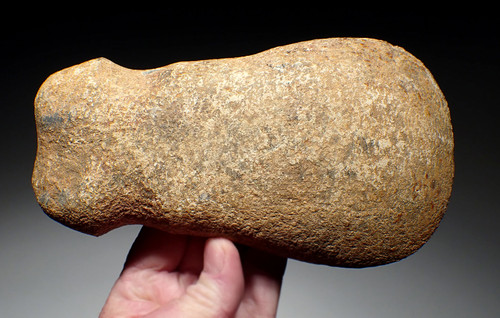Product Description
SEE MORE AFRICAN NEOLITHIC ARTIFACTS
We have been obsessively collecting the finest African Neolithic artifacts for over 20 years and this specimen comes from our private collection that we are now offering for sale. Over the past two and a half decades, we have purchased amazing private collections in America and Europe. In all this time, we would set aside the RAREST OF THE RAREST objects of African Neolithic cultures, and it is now time for us to sell some from this collection of ultra-rare objects. The collection is small and limited, and once sold, would be impossible to recreate due to changed legislation and site depletion. Each specimen represents the highest grade of its kind that we have ever seen. This is one of those precious pieces from such efforts. The sites where these artifacts were once found, have been entirely picked clean for years, not to mention are now protected from any further exploration.
This is a West African Neolithic Sahel large hardstone ground and grooved celt war axe. With its weight and size, an axe like this would surely have been able to inflict a deadly blow if an enemy was struck in head. Body blows would have caused easy breakage of major bones. This uncommonly large war axe would have been mounted into wooden shaft handle and lashed with cord and sinew, by the grooved feature on the body. Made from an unusual type of speckled green hardstone, the entire surface has ancient sediment minerals attached deep in all micro-crevices when examined under magnification. Such a trait is only seen in unaltered, authentic ancient stone objects such as this, and the presence of such deposits as seen in the above photos, show that this is a 100% original and authentic Neolithic specimen. Acquired from an old French collection dated back to the 1960's - 70's.
Laying exposed in the desert for thousands of years, this amazing crown jewel artifact shows a mesmerizing desert varnish natural polish. Amazingly, this large war axe has survived intact and with perfect 'as made' preservation. In all the decades we have been collecting and traveling, we have never seen a Neolithic Saharan object of this nature. It is safe to say it truly is a once-in-a-lifetime acquisition!
In West Africa, which may have been a major regional cradle in Africa for the domestication of crops and animals, people domesticated the helmeted guinea fowl between 5500 BP and 1300 BP, while domestication of field crops occurred throughout various locations in West Africa, such as yams in the Niger River basin between eastern Ghana and western Nigeria (northern Benin), rice in the Inner Niger Delta region of Mali, pearl millet in northern Mali and Mauritania, and cow peas in northern Ghana.
HISTORY
The Neolithic in West Africa, when people increasingly produced their own food instead of hunting, fishing or collecting it as before, developed during a humid phase around 5000 BC. The invention of ceramics which was long thought to emerge in the earliest Neolithic, appeared at the central Malian site of Ounjougou dating to about 9,400 BC, and is believed to be an instance of the independent invention of pottery. The earliest Neolithic is attributed to the phase of self-production of food, although no plants were cultivated and no cattle were kept.
The middle Neolithic is marked by first traces of nomadic cattle breeders (again) around 4000 BC. Around 3500 BC, the relatively humid climate came to an end. A thousand years later, the dry phase, which apparently drove cattle nomads from the east to Mali, reached its peak. The northern lakes dried up and the population mostly moved south.
The late Neolithic was marked by renewed immigration from the Sahara around 2500 BC which had grown into an enormously spacious desert.
Approximated to the Neolithic, there were Negroid skeletal remains found in West Africa. At El Guettara, Mali, there were two individuals found. At Karkarichinkat South, Mali, a skull was found. At Ibalaghen, Mali, there was a cranium found. At Tin Lalou, Mali, there was a cranium and mandible found. At Tamaya Mellet, Niger, there were 12 individuals found. All of these remains have been specifically dated between 5000 BC and 2000 BC.
 US DOLLAR
US DOLLAR
 EURO
EURO
 AUSTRALIAN DOLLAR
AUSTRALIAN DOLLAR
 CANADIAN DOLLAR
CANADIAN DOLLAR
 POUND STERLING
POUND STERLING






























